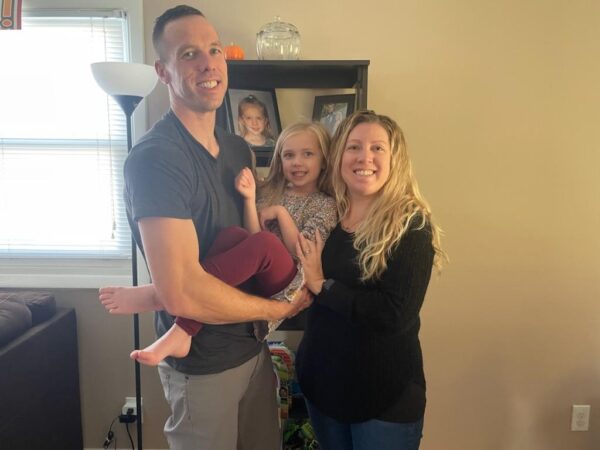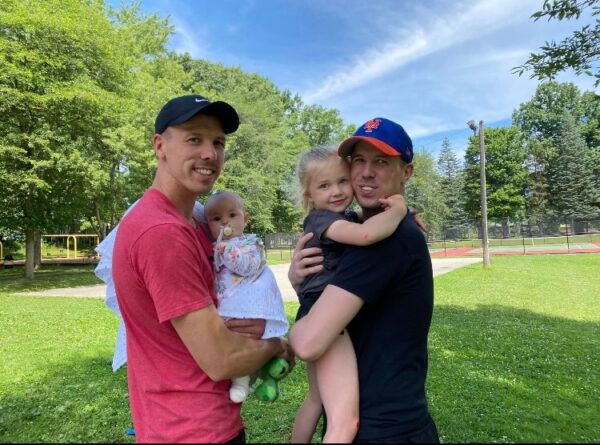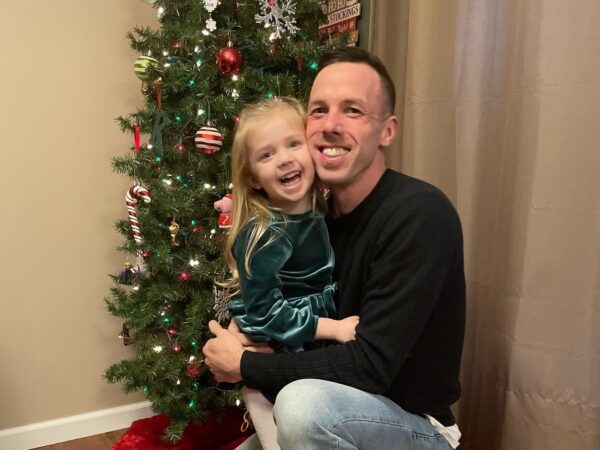
Kenny Roberts, shown with wife Kristen and daughter Jade, underwent a new catheter ablation procedure, called cardioneuroablation. The procedure has the potential to eliminate the need for his pacemaker.
Certain things stick out clearly in Kenny Roberts’ mind, especially the day he passed out while playing basketball 27 years ago. He remembers being rushed by ambulance to Akron Children’s emergency room. Later, it was the look on his parents’ faces when they learned Kenny had an abnormal heartbeat that required a pacemaker to ensure his heart beat normally and consistently.
Kenny, then 12 years old, learned he had intermittent heart block with syncope, which meant his heart stopped beating and caused him to faint. An electrocardiogram confirmed that Kenny had a disruption in the electrical signals between the upper and lower chambers of his heart.
Within days, a pacemaker was implanted in Kenny’s chest to help his heart beat normally. Once Kenny realized the pacemaker wouldn’t affect his ability to play basketball and baseball with his brothers and cousins, the device became something cool to tell his friends.
“I looked at it as being unique, especially at that age,” said Kenny, age 39 of Tallmadge, Ohio. “The look on other kids’ faces was one of awe.”

Kenny Roberts (far right) is shown with his brothers (left to right): Jordan, who is Kenny’s twin, Dusty and Pat. Kenny’s twin brother has the same condition as Kenny and also wears a pacemaker.
Life with a pacemaker
For the most part, Kenny gives little thought to his pacemaker, accepting it as a necessity in his life. The device makes its presence known, however. Besides feeling it through his skin, the pacemaker conducts daily device self-checks where it slows down, then speeds up, making Kenny’s heart race as if he’s exercising. He also carries a pacemaker ID card to alert medical personnel in emergencies and sees Pediatric Cardiologist and Director of Akron Children’s Pediatric Arrhythmia Center John Clark, MD, twice a year.
It was during a recent visit with Dr. Clark that Kenny learned about a new catheter ablation procedure, called cardioneuroablation. It had the potential to eliminate the need for his pacemaker. Kenny, whose pacemaker is due for a replacement in two-and-a-half years, fit the target age range for this new procedure: 20-to 40-year-olds.
“The cardioneuroablation procedure was recently introduced to the United States,” said Dr. Clark. “We’ve adapted cardioneuroablation to not only offer it to new patients to treat a new problem, but we also do it differently than the rest of the world is doing it. We’re able to do this procedure without exposing the patient to radiation.”
Adapting a common cardiac ablation procedure
Previously, Dr. Clark and his team used the cardiac ablation procedure to treat people with abnormally fast heart rhythms. Now, they’re using it to treat areas of the heart that cause it to beat too slow.
“This is a fantastic new therapy, but it doesn’t apply to everybody,” Dr. Clark said. “Right now, the indications for it are people who have heart rates that are too slow or pauses where the patient has three seconds or more with no heartbeat.”

Kenny Roberts (left) and his twin brother Jordan enjoy family time with their children. Like Kenny, Jordan has an intermittent heart block with syncope, which means his heart stops beating and causes him to faint. Both brothers wear pacemakers to ensure their hearts beat normally and consistently.
According to Dr. Clark, Akron Children’s is the first hospital in the state — and one of only a few in the country — to offer cardiac ablation to treat slow heart rates. The procedure is performed using 3-D mapping instead of X-ray (fluoroscopy) imaging during catheter ablation, so patients have zero radiation exposure – a technique pioneered by Dr. Clark and his team in 2005.
How the cardioneuroablation procedure is done
Kenny was eager to try the new procedure, which is less invasive and offers a quicker recovery time than implanting a pacemaker. With a pacemaker, Kenny had to be on guard to protect his chest. Plus, a pacemaker is a mechanical device that has a limited battery life, requires surgery to revise it and exposes patients to risks of infection and complications.
Cardioneuroablation is an outpatient procedure that takes about five hours to perform. Dr. Clark inserts intravenous lines in the patient’s leg veins and threads ablation catheters through these to the heart. Using 3-D mapping, he stimulates the vagus nerve, documenting which spots cause the heart rate to slow or stop. Then, he finds the areas of the heart where these nerves enter the heart and cauterizes them to eliminate the irregular electrical signals.
Once testing and verification is done, the patient goes to recovery, then home. The next day, patients can resume their usual activities and within three days, they’re able to return to full contact sports.

Kenny Roberts had a cardioneuroablation procedure in August 2022 and noticed an immediate improvement in the way his pacemaker functioned. Kenny went through genetic testing to make sure he doesn’t have a genetic abnormality that could be passed down to his daughter. It came back inconclusive for a genetic abnormality.
Looking to the future
Kenny underwent cardioneuroablation in August 2022 and noticed an immediate difference. His pacemaker, now set at the lowest setting, no longer paces to help his heart beat. If this continues for one year, the pacemaker will be shut off, but remain implanted. If it looks good after that year, the device may be removed permanently.
Kenny’s interest in the procedure extends beyond his own personal health. Since his twin brother, Jordan, also has an abnormal heartbeat and wears a pacemaker, Kenny is concerned about his 5-year-old daughter. However, genetic testing came back inconclusive for a genetic abnormality. It’s something the Roberts family and Dr. Clark will continue to watch.
Dr. Clark is excited by the procedure’s potential and the fact that Akron Children’s is accomplishing it without exposing patients to radiation.
“This procedure has the potential to eliminate the need for medical devices and heart medications from patients’ lives forever,” Dr. Clark said. “It’s life changing for many patients. It’s huge for us, too, to be able to offer the best possible care to our patients and broader community. It’s an amazing opportunity for so many heart patients.”










